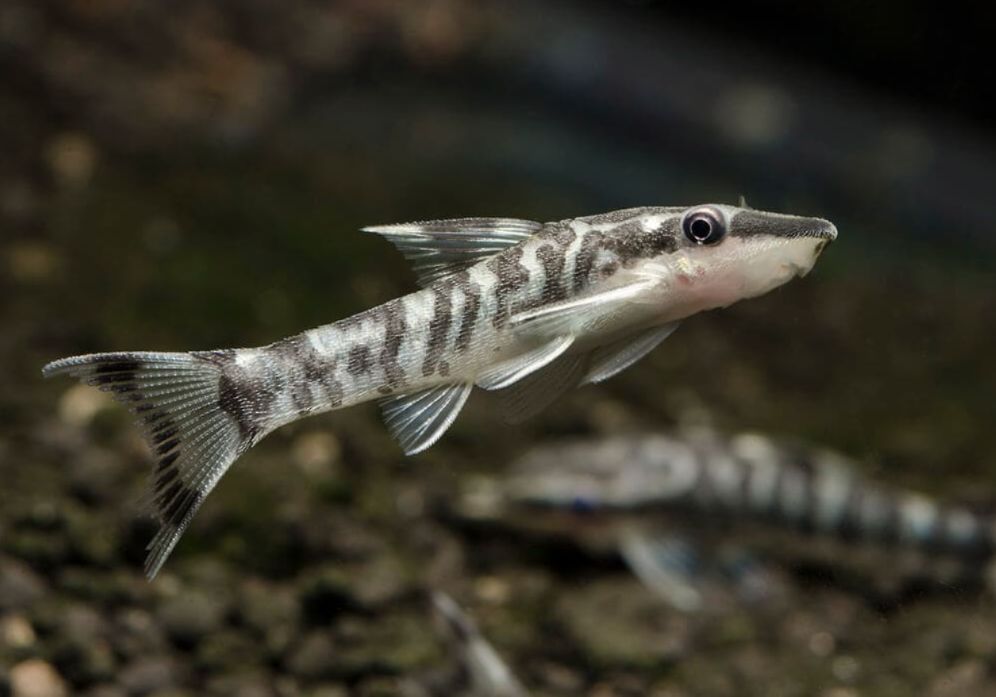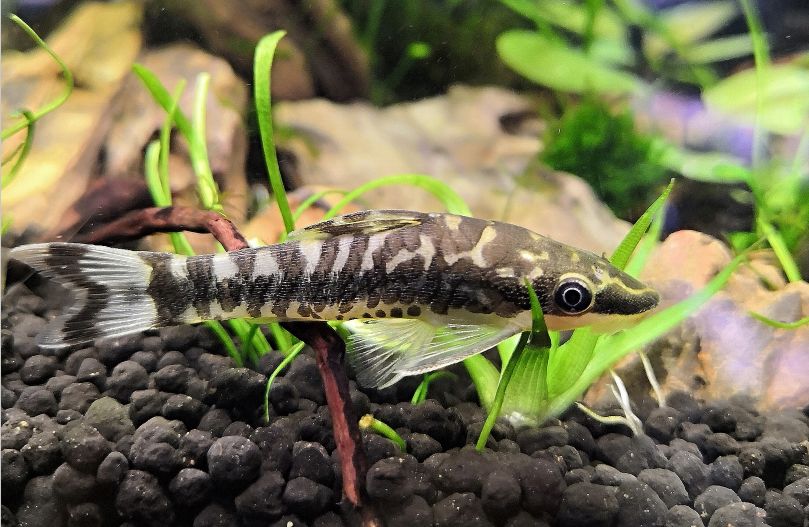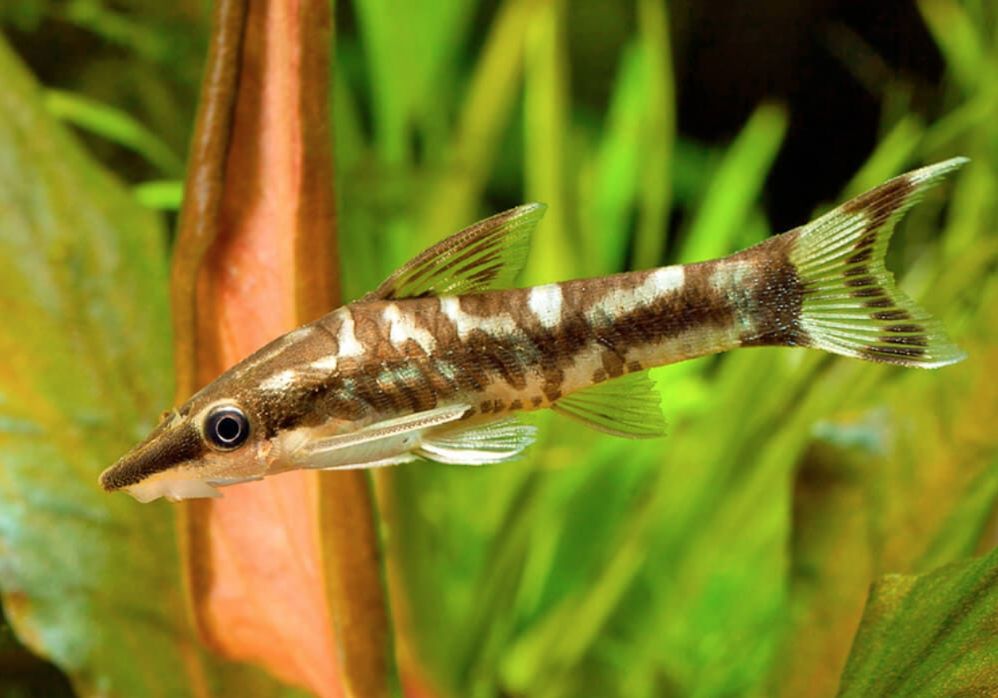Zebra otocinclus is one of the smallest catfish species from the Loricariidae family, making it a delightful addition to any aquarium. Known for its diligent algae-eating abilities, this species plays a crucial role in maintaining a clean tank environment. Unlike its more commonly found relative, Otocinclus affinis, zebra otocinclus is less frequently encountered in the aquarium trade, which can make it a unique find for enthusiasts.

Contents
Habitat in the wild
The zebra otocinclus, commonly known as zebra oto, is a small freshwater fish from the Loricariidae family, often referred to as the “suckermouth catfish” family. This family includes a variety of species, many of which are popular in the aquarium hobby due to their unique feeding habits and algae control capabilities.
Zebra otocinclus are easily recognized by their distinctive sucker-like mouths, which they use to attach themselves to surfaces in the aquarium, such as glass, plants, and decorations. As primarily bottom-dwellers, these fish are exceptional at helping control algae growth, making them a valuable addition to any community tank.
Native to the Amazon River basin in Peru, zebra otocinclus inhabit slow-moving streams, tributaries, and shallow waters within the rainforest. Their natural environment is characterized by a mix of aquatic vegetation, submerged tree roots, rocks, and leaf litter. These habitats typically feature gentle water currents and dense plant cover, providing both shelter and food sources.
In the wild, the water is usually clear, well-oxygenated, and falls within a tropical temperature range. To replicate these conditions in your aquarium, it’s crucial to maintain clear, well-oxygenated water with stable temperatures. This will help ensure the health and well-being of zebra otocinclus when kept in captivity. Additionally, providing plenty of hiding spots and plants will mimic their natural habitat and encourage natural behaviors.
| Scientific Name | Otocinclus cocama |
| Family | Loricariidae |
| Common Names | Zebra oto; zebra otocinclus; tiger otocinclus; otocinclus zebra |
| Ease of keeping | Hard |
| Lifespan | up to 5 years |
| Tank size | 13 gallons and more |
| Temperament | Peaceful |
| Tank type | Community of small fishes |
| Diet | algae eater |
| Temperature | 22 – 26 °C (71-79 °F ) |
| pH | 6.0-7.5 |
| Water hardness | 4–18 dGH |
| Size | 4.5 cm (1.8 inches) |
Description
Size
The Otocinclus cocama is a relatively small fish, typically reaching a size of about 1.5 to 2 inches (3.8 to 5 centimeters) in length when fully grown. This compact size makes them well-suited for smaller aquariums and community tanks, where their peaceful nature and algae-eating behavior are highly valued. Due to their size, they can navigate smaller spaces and coexist peacefully with other small, non-aggressive fish species.
Lifespan
The lifespan of zebra otocinclus in captivity can vary based on factors such as water quality, diet, tank conditions, and overall care. Generally, when well-cared for in a suitable aquarium environment, zebra otocinclus can live for around 3 to 5 years. However, it’s important to note that individual lifespans can differ, and some may live longer or shorter than this average range.
Body
The zebra otocinclus features a body shape similar to that of other Otocinclus species, characterized by its small size, suckermouth, and armored body. This distinct shape not only aids in its feeding habits but also allows it to navigate effectively through its aquatic environment. The unique coloration and patterning of zebra otocinclus serve as camouflage in their natural habitat, helping them blend in with the dense aquatic vegetation.
What sets the zebra otocinclus apart from its relatives is its unique coloration. The head and back display a bluish-white or slightly yellowish hue, while the top of the head and the area between the nostrils are black. The underside of the fish’s head is light yellow, creating a striking contrast. The sides of the head and the areas behind the eyes are black, adorned with a V-shaped white stripe on the fish’s face.
On the back and sides of the zebra otocinclus, you can find four elongated black or dark gray spots: the first spot is positioned at the beginning of the dorsal fin, the second is located behind the dorsal fin, the third is situated between the dorsal and caudal fins, and the fourth is at the start of the caudal fin. Additionally, the zebra otocinclus features a black spot on its tail stalk and a distinctive W-shaped vertical stripe on its caudal fin, distinguishing it from other species within the Otocinclus genus.
| Characteristic | Description |
|---|---|
| Scientific Name | Otocinclus cocama |
| Common Names | Zebra Otocinclus, zebra oto, tiger otocinclus |
| Family | Loricariidae |
| Origin | Amazon River basin, primarily in Peru |
| Habitat | Slow-moving streams, tributaries, and shallow waters with aquatic plants and submerged roots |
| Size | Typically grows to around 1.5-2 inches (3.8-5 cm) |
| Lifespan | 3-5 years (with proper care) |
| Temperament | Peaceful and non-aggressive, suitable for community aquariums |
| Diet | Primarily herbivorous, feeding on algae and plant matter |
| Water Parameters | Temperature: 75-82°F (24-28°C), pH: 6.5-7.5, soft to moderately hard water |
| Tank Size | A 10-gallon (38-liter) tank is suitable for a small group |
| Behavior | Bottom-dwelling, frequently attaches to surfaces using their sucker-like mouths |
| Care Level | Moderate – requires a well-maintained aquarium with good water quality and proper diet |
| Algae Control | Effective at controlling algae, but supplemental feeding may be necessary |
| Compatibility | Generally compatible with peaceful fish species and other small, non-aggressive fish |

Difficulties in keeping
The zebra otocinclus can be a demanding and challenging species to keep in home aquariums. Many of these fish are still sourced from their natural habitats, which can lead to high mortality rates during the acclimatization period. This is often due to stress from transport and the difficulty in adjusting to new water conditions.
Zebra otocinclus are particularly sensitive to water quality, making them more susceptible to illness if conditions are not ideal. Therefore, it’s beneficial to acclimate them slowly when introducing them to a new tank, which helps reduce stress and increases their chances of survival. Additionally, keeping zebra otocinclus in a well-planted aquarium can create a stable environment that mimics their natural habitat, aiding in their adaptation and overall health.

Keeping in a tank
Tank size
Choosing the right tank size for zebra otocinclus is crucial for their health and well-being. The appropriate volume depends on the number of fish you plan to keep. Zebra otocinclus are small fish, typically reaching about 1.5 to 2 inches (3.8 to 5 cm) in length, meaning they don’t require a massive tank. However, providing enough space and the right conditions is essential for their happiness.
A 10-gallon (38-liter) tank is generally considered the minimum size for a small group of zebra otocinclus. This size allows for adequate swimming space and helps maintain stable water quality. Keeping a minimum of 4 to 6 individuals is recommended, as zebra otocinclus are social creatures that thrive in groups, which helps reduce stress and encourages natural behaviors.
While a 10-gallon tank can work for a small group of zebra otocinclus, providing a larger tank is preferable. Tanks larger than 10 gallons allow for more companions, a more stable ecosystem, and a better overall environment for these fish.
Water parameters
Maintaining suitable water parameters is essential for the health and well-being of zebra otocinclus. These fish thrive in conditions that closely resemble their natural habitat. The key parameters to monitor include:
Temperature
Zebra otocinclus prefer a tropical temperature range. The ideal temperature is between 75°F and 82°F (24°C to 28°C). Keeping the water temperature stable within this range helps support their metabolic functions.
pH
The pH level should be maintained within a slightly acidic to neutral range, ideally between 6.5 and 7.5. This pH range helps create a comfortable environment for the fish.
Water Hardness
Zebra otocinclus thrive in relatively soft to moderately hard water. Aim for a general hardness (GH) of 2 to 12 dGH. Soft water is closer to their natural habitat and supports their overall health.
Ammonia and Nitrites
Crystal-clear water is crucial for zebra otocinclus, with zero tolerance for ammonia and nitrite levels. Both compounds are toxic to fish, so regular water testing is essential, especially during the initial setup of the aquarium.
Nitrates
While zebra otocinclus can tolerate low to moderate levels of nitrates, it’s best to keep them as low as possible, ideally below 20 ppm (parts per million). Elevated nitrate levels can stress the fish and lead to health issues.
Filtration
A high-quality filtration system is important for maintaining water quality, as zebra otocinclus are sensitive to poor conditions. While an external filter is preferable, an internal filter can also suffice in smaller tanks.
Water Movement
Zebra otocinclus come from slow-moving streams, so aim for gentle water circulation to mimic their natural environment. Too much current can cause stress and hinder their ability to graze on algae.
Regular Maintenance
Regular water changes, about 20-25% every 1-2 weeks, are essential to maintain stable water conditions and remove accumulated toxins. Monitoring these parameters will help create a healthy environment for your zebra otocinclus.
Diet
Zebra otocinclus have a primarily vegetarian diet, making them efficient algae eaters in both their natural habitat and in home aquariums. In the wild, they primarily feed on algae and biological fouling, scraping these from surfaces using their specialized mouths.
During the adaptation period in a new aquarium, it’s essential to provide an environment rich in green and brown soft algae. These algae should form a biofilm on tank plants and decorations, as zebra otocinclus will graze on this biofilm. Without sufficient algae, the fish may struggle to find enough food and could starve.
As zebra otocinclus acclimate to their new environment, they can gradually be introduced to additional food options. High-quality spirulina flakes or pellets designed for herbivorous catfish species are excellent choices. Alongside these, natural foods such as vegetables can also be included in their diet. Some of the best options are:
- Cucumbers: Sliced and blanched to soften them for easier consumption.
- Marrow squash: Cut into small pieces to encourage feeding.
- Parboiled spinach: Provides essential nutrients and is easily digestible.
While zebra otocinclus can consume other types of food, it’s crucial that their diet remains predominantly plant-based. Ensuring a varied and nutrient-rich diet will promote their health and vitality in the aquarium.
Zebra otocinclus can adapt to various food sources, but their diet must contain a large amount of vegetable matter to maintain optimal health. Offering a mix of both natural and prepared foods will help replicate their natural foraging behavior and keep them thriving.
Tank mates
Zebra otocinclus are peaceful fish that can thrive in a community tank, but their small size and timid nature make them vulnerable to larger or more aggressive tank mates. For their safety and well-being, it’s often best to keep them in a species-specific tank or with other small, peaceful fish, such as guppies or neon tetras. Small shrimp, like red cherry shrimp, can also be compatible tank mates.
As a schooling species, zebra otocinclus should be kept in groups of at least six individuals. This social structure not only reduces stress but also encourages natural behaviors. A densely planted tank is essential, as these fish are active during the day and will graze on algae from the leaves of aquatic plants. The plants also provide shelter, making the fish feel more secure.
Without adequate plants and hiding spots, zebra otocinclus may experience stress, which can lead to various health issues and a shortened lifespan.
There are some reports of zebra otocinclus nipping at the sides of other fish. However, such behavior is likely a result of stress or insufficient vegetable content in their diet rather than aggression.
Gender differences: male vs female
Distinguishing between male and female zebra otocinclus can be quite challenging, particularly when they are not in breeding condition. Unlike some other fish species, where males exhibit more vibrant colors or distinct physical traits, the visual differences between male and female zebra otocinclus are subtle and often not well-defined.
During the breeding season, females may appear slightly rounder and plumper due to the development of eggs, but these differences can be difficult to discern without close observation. Generally, the most noticeable changes occur only when the fish are in breeding condition.
In the absence of clear physical differences, observing the behavior of the group can provide insights into their reproductive readiness. Look for courtship behaviors, such as chasing or clustering, which may indicate that the fish are preparing to breed. However, these behaviors can be challenging to observe in a home aquarium due to the natural shyness of zebra otocinclus.
Breeding
Breeding zebra otocinclus in a home aquarium can be a rewarding but challenging endeavor. To encourage successful breeding, it’s crucial to provide specific conditions and careful attention. Start with a group of healthy zebra otocinclus, ideally comprising a balanced mix of males and females. A group of six or more individuals is recommended to increase the chances of pairing and successful breeding.
A separate breeding tank with a minimum size of 10 gallons (38 liters) provides adequate space for the fish to establish territories and breed. It’s essential to maintain stable and suitable water conditions, aiming for a temperature between 78-82°F (25-28°C) and a pH level of 6.5 to 7.5. The water should be relatively soft to moderately hard. Providing subdued lighting mimics their natural habitat, as zebra otocinclus are typically found in well-vegetated areas with diffuse lighting. Additionally, a varied and balanced diet is crucial for conditioning the fish. Offer high-quality foods, including algae-based options, sinking pellets, and small live or frozen foods to ensure they receive proper nutrition.
In the weeks leading up to the breeding attempt, feed your zebra otocinclus a high-quality diet to ensure they are in optimal condition. Providing plenty of hiding spots using live plants or spawning mops will serve as potential breeding sites. To simulate the rainy season, which may trigger spawning behavior, perform a large water change with slightly cooler water. Alternatively, a more substantial water change at the same temperature can also induce spawning.
Look for signs of courtship, such as males chasing females and inspecting potential spawning sites. When a female is ready to spawn, she will attach her eggs to surfaces like the undersides of leaves or other objects in the tank. Once spawning occurs, it’s advisable to separate the eggs or fry to protect them from being eaten by adult fish or other tank mates. You can use a breeding box or transfer the eggs to a different tank.
Breeding zebra otocinclus can be challenging, and success may not be guaranteed. Patience, attention to water quality, and providing suitable conditions are key factors in increasing your chances of successful breeding. If you are fortunate enough to breed them, providing a separate rearing tank for the fry will give them the best chance of survival.
Interestingly, zebra otocinclus are known for their social nature, so keeping them in groups not only encourages breeding but also helps reduce stress. In the wild, zebra otocinclus exhibit some parental care, with some species guarding their eggs; however, this behavior is not typically observed in captivity. Once hatched, the fry can be fed infusoria or finely crushed flakes until they are large enough to eat powdered spirulina or small sinking pellets. Providing these conditions and considerations will significantly enhance your chances of successfully breeding zebra otocinclus in your home aquarium.